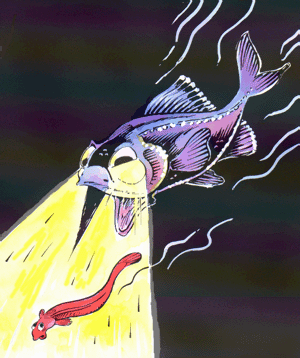
A click on the image will take you to the series of illustrated quizzes which will appear in random order or you may click on this image quiz link.
Just one example of the ocean's bioluminescence in action.
Bioluminescence occurs when a pigment, usually "luciferin"; is oxidized without giving off heat.
Although it is believed that bioluminescence is involved in animal communication, its function in many organisms has yet to be understood.
Bioluminescence is a form of "chemiluminescence" and most luminescent animals have an effulgent-producing organ; such as, "photophore".
Such bioluminescence may contain their own specialized luster-producing cells, or have symbiotic luminescent bacteria.

The darkness of the ocean presents a variety of bioluminescent creatures
The most expansive animal habitat on the earth lies between the sea surface and the floor of the deep ocean basins. Within this enormous space live the largest and perhaps most remarkable biological communities of fauna.
Most creatures of this twilight world are able to augment the scant sunlight reaching them with another form of natural illumination known as bioluminescence.
Although bioluminescence is a relatively rare phenomenon in terrestrial ecosystems, the vast majority of the animals that inhabit the upper kilometer of the ocean are capable of producing light with photophores in one way or another.
The illustrated bioluminescent fish for this page is similar to a "flashlight fish" which has headlights made up of sacs of luminescent bacteria under its eyes that light its way around the ocean depths.
Before man caught up with nature, she developed her own uses for bioluminescence; for example, many predators use their natural lighting to catch their meals; as shown in the image.
